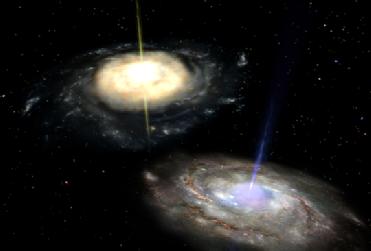
Frame from animation showing two spiral galaxies, each containing a massive black hole at the centre, in the early stages of a merge. Credit: M. Librero/R. Coburn, NAS Division
GENEVA (BNS): A team of theoretical and experimental physicists, with participants from Case Western Reserve University, has designed a new black hole simulator called BlackMax to search for evidence that extra dimensions might exist in the universe.
Black holes are theorised to be regions in space where the gravitational field is so strong that nothing can escape its pull after crossing what is called the event horizon. BlackMax simulates these regions.
Approximately two years in the making, the computer program enables physicists to test theories about the production and decay of black holes and takes into account new types of effects on both the creation and evaporation of black holes at the LHC.
Black holes created at the LHC would be expected to start off spinning.
The spinning of black hole increases the fraction of black hole's mass that is dissipated as gravitons–elementary quanta of gravity, which could be used to provide a clue to the existence and structure of extra dimensions.
Black holes are being studied with BlackMax by members of the ATLAS Experiment at LHC, one of the two principal large particle detectors at the new collider.
ATLAS works much like investigators who search the site of plane crash, and then piece together the debris to find the cause of the plane's disintegration.
BlackMax, by predicting how those pieces will fall, should allow physicists looking at data from the ATLAS experiment to see whether the pattern of particles released into the detector matches what one would expect when a black hole is produced and then falls apart.
The ordinary non-gravitational collisions predicted by Standard Model of particle physics tend to produce fragments of the proton clumped into a small number of jets.
Decays of black holes should produce more particles than usual. These particles should also come out unusually isotropically, like electrons and similar particles that are not found within the proton.
Under certain circumstances, black hole decay should also produce many gravitons that would themselves pass unnoticed out of the ATLAS, but which would make the remaining emitted particles looking asymmetric and carrying less than the full event energy.
According to researchers, if black holes are found at the LHC, it will enable scientists to understand the connection between gravity and quantum mechanics, resolving the inconsistency between quantum mechanics and Einstein's General Theory of Relativity.
It would also mean the existence of other dimensions in space, and explain why gravity is such a weak force compared to the other three fundamental forces of nature -- electromagnetism and the strong and weak nuclear forces.
 Previous Article
Previous Article Next Article
Next Article













The Indian Air Force, in its flight trials evaluation report submitted before the Defence Ministry l..
view articleAn insight into the Medium Multi-Role Combat Aircraft competition...
view articleSky enthusiasts can now spot the International Space Station (ISS) commanded by Indian-American astr..
view article